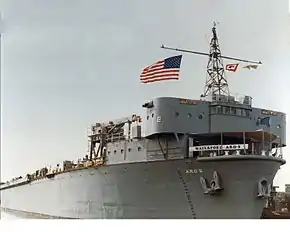Auxiliary floating drydock
Auxiliary floating drydock are US Navy floating dry docks that are able to submerge under water and be placed under a ship in need of repair below the water line. Floating drydocks then rise up under the ship raising the ship out of the water. The ship is now blocked on the deck of the floating dry dock for repair. Most floating drydocks had no engine and are towed by tugboats to locations. Floating dry docks come in a different sizes to accommodate varying ship sizes. The large floating drydocks come in sections and can be assembled together to increase the size and lift power. Ballast pontoons tanks are flooded with water to submerge or pumped dry to raise the ship.[1]

.JPEG.webp)

_in_Drydock_Dewey.jpg.webp)
World War 2
When World War 2 started the US Navy had only three steel auxiliary floating dry docks:
- Auxiliary floating drydock YFD-2 built in 1901 was at Pearl Harbor. YFD-2 was repairing the US destroyer USS Shaw on 7 December 1941 during the attack on the harbor. YFD-2 and USS Shaw were hit and damaged in the attack, both were repaired.[3]
- The auxiliary floating drydock USS Dewey built in 1905, was scuttled at Mariveles to prevent its capture by the Japanese. In 1942 Japan raised the Dewey, but it was resunk by U.S. forces.
- Auxiliary floating dry dock USS ARD-1, built in 1933, was also at Pearl Harbor. USS ARD-1 was a self-sustaining mobile dry dock.
To reduce travel time for repair work, over 150 auxiliary floating dry docks of different sizes were built during World War 2, between 1942 and 1945. These new floating dry docks built had a 400 to 100,000 ton lift capacity. Without these forward repair bases, ships would have to return to the states for repair. Between 1 October 1944 and 17 October 1945 7,000 ships were repaired in auxiliary floating dry docks. After World War 2 some of the auxiliary floating dry docks were sold for private use and a few were scrapped. Timber floating dry docks were built also for World War 2. These Timber floating dry docks had a lift capacity from 400 to 20,000 tons. These were not towed across the open ocean and were not given a US Navy class.[4]
Role
Ships in continuous use during war need repair both from wear and from war damage such as naval mines, kamikaze attacks, dive bombs and torpedoes. Rudders and propellers are best serviced on dry docks. Without remote on location dry docks, months could be lost in a ship returning to a home port for repair. Most auxiliary floating drydock had provisions for the repair crew, such bunk beds, meals, and laundry. Most had power stations, ballast pumps, repair shops, machine shops, and mess halls to be self-sustaining. Some of the auxiliary floating drydocks also had provisions for the ship under repair, but when possible, the crew of the damaged ship remained on their ship while repair was being made. Many had cranes able to lift tons of material and parts for removing damage parts and install new parts.[5]
Armament
Most auxiliary floating drydocks only have anti-aircraft guns for defense, as space would not allow for large guns. Typical armament were 40 mm and 20 mm machine guns. Japanese pilots sometime mistook empty auxiliary floating drydocks for a type of aircraft carrier.[6]
Large Auxiliary Floating Dry Docks (AFDB)
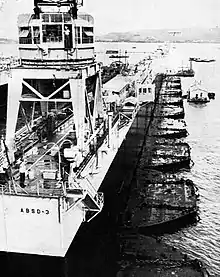
Auxiliary Floating Docks, Big, came in sections that are 3,850 tons and are 93 feet long each. Each Section had a 165 feet beam, a 75 feet molded depth and had 10,000 tons lifting capacity each. They are also known as Advance Base Sectional Docks (ABSD). Sections could be put together to lift larger ships. AFDB were needed to repair battleships, aircraft carriers, cruisers, and large auxiliary ships. AFDB-1 Artisan had 10 sections (A to J) for a total lift of 100,000 tons and was 1,000 feet long with all 10 sections installed. AFDB-1 to 7 were built between 1943 and 1945 and then towed to remote navy bases. An AFDB would have a crew of 600 to 1000 men, have a fresh-water distilling plant and be self-sustaining. They had a rail traveling 15-ton capacity crane with an 85-foot radius and two or more support barges. To pump out the water in the tanks there were two 24-inch discharge pumps on each section, each pump rated 15,000 gpm. For power there were two 350-kw diesel AC generators on each section, producing 440 volts 3-phase 60-cycle power. Had steam plants to run the pumps. Each section could store 65,000 gal. of fuel oil, this was to supply the ships under repair. For the crew to live next to the AFDB the Navy had barracks ships called APL, that dock next to the AFDB.[4][7][8]
- USS Artisan (ABSD-1) (A-J) built by Everett-Pacific and others.
- USS AFDB-2 (A-J) Built by Mare Island Naval Shipyard in Vallejo, California (E, F, H & I in use)[9]
- USS AFDB-3 (A-I) Saw fighting action in Guam, sold to Croatia in 2000[10][11]
- USS AFDB-4 (A-G) Built by Mare Island NSY, Air attacked on April 27, 1945. Partially sunk 1989 as reef.[12][13]
- USS AFDB-5 (A-G) Built by Chicago Bridge in Morgan City, Louisiana, scrapped in 1997[14]
- USS AFDB-6 A-G) Built by Mare Island NSY, scrapped 1976[15]
- USS Los Alamos (AFDB-7) A-G) Built by Chicago Bridge sold to private shipyard in 1995
Post WW2
- AFDB-8 Machinist Built by Seebeckwerft in Germany Sold to Guam in 1997
- AFDB-9(A-B) built by Sun Shipbuilding in Chester, Pennsylvania, sold to private in 1985, Galveston
Medium Auxiliary Floating Dry Docks (AFDM)

AFDM are from 6,800 to 8,000 tons and are from 528 to 622 feet long. AFDM has crew of 140 to 200 men. AFDM had a lift capacity 18,000 tons and armed with two 40mm and four 20mm guns. Had two 7 1⁄2-ton cranes with 16 ballast tank compartments. AFDM were built in three pieces, a long center section and two shorter sections at each end.[4][16][17] All AFDM had Yard Floating Docks (YFD) class numbers also.
- USS AFDM-1 Chicago Bridge, YFD 3, was floated through the Panama Canal on it side, scrapped in 1986[18]
- USS AFDM-2 Alabama DD, YFD 4, sold to private in 1999[19]
- USS AFDM-3 Chicago Bridge, through the Panama Canal on it side, YFD 6, sold to private[20]
- USS AFDM-4 Chicago Bridge, YFD 10 sold private in 1948
- USS Resourceful (AFDM-5) Everett-Pacific, YFD 21, sold private in 1999[21]
- USS Competent (AFDM-6) Everett-Pacific, YFD 62, sold private in 1997[22][23]
- USS Sustain (AFDM-7) Everett-Pacific, YFD 63, leased to BAE Jacksonville in 1997[24]
- USS Richland (AFDM-8) Chicago Bridge, YFD 64, scrapped in 2016[25]
- USS AFDM-9 Chicago Bridge, YFD 65, sold private in 1989
- USS Resolute (AFDM-10) Chicago Bridge, YFD 67, destroyed 1947[26]
- USS AFDM-11 Chicago Bridge, YFD 68, sold private in 2004
- USS AFDM-12 – Kaiser Shipyards in Vancouver, Washington, YFD 69, scrapped in 1990
- USS AFDM-13 – See YFD 70 Columbia Const. in Vancouver WA, sold private in 1969,
- USS Steadfast (AFDM-14) Pollock-Stockton in Stockton, California, YFD 71, sold private in 1998[27]
_in_floating_drydock_Steadfast.jpg.webp) USS Kinkaid (DD-965) in floating drydock Steadfast
USS Kinkaid (DD-965) in floating drydock Steadfast
Medium Auxiliary Repair Docks (ARDM)
Auxiliary repair dock Mobile (ARDM) are 5,200 tons and are 489 feet long. ARD had a ship form hull and lifting capacity of 3,500 tons. ARDM were used to repair destroyers, submarines, and small auxiliaries. ARDM has a crew of 130 to 160 men.[4]
- USS Oak Ridge (ARDM-1) by Pacific Bridge Company, Now US Coast Guard
- USS Almagordo (ARDM-2) by Pacific Bridge, Now in Ecuador
- USS Endurance (ARDM-3) by Pacific Bridge, Now in South America
Post WW2
- USS Shippingport (ARDM-4) by Bethlehem Steel, US Navy Active
- USS Arco (ARDM-5) by Todd Pacific Shipyards in Seattle WA, US Navy Active
Small Auxiliary Floating Dry Docks (AFD - AFDL)
_prepares_for_an_incoming_craft.jpg.webp)
Auxiliary Floating Docks, Light (AFDL). Also called Auxiliary Floating Docks (AFD). AFD were 288 ft long, had a beam of 64 ft (20 m), and draft of 3 ft 3 in empty and 31 ft 4 in (9.55 m) flooded to load a ship. A normal crew was 60 men. AFDL displacement 1,200 tons and could lift 1,900 tons. AFDL were built as one piece, open a both ends. A few were AFDL has a crew of 30 to 130 men, living in a barge alongside the AFDL. Used to repair small crafts, PT boats and small submarines. All AFD were reclassified AFDL after the war in 1946.[4][28][29]
- USS Endeavor AFD-1 – AFDL-1 By Chicago Bridge
- USS AFD-2 By Chicago Bridge[30]
- USS AFD-3 – AFDL-3 By Chicago Bridge[31]
- USS AFD-4 – AFDL-4 By Chicago Bridge[32]
- USS AFD-5 – AFDL-5 By Chicago Bridge[33]
- USS Dynamic (AFD-6) – AFDL-6 By Chicago Bridge[34]
- USS Ability (AFD-7) By Chicago Bridge[35]
- USS AFD-8 – AFDL-8 By Chicago Bridge[36]
- USS AFD-9 – AFDL-9 By Chicago Bridge[37]
- USS AFD-10 – AFDL-10 By Chicago Bridge[38]
- USS AFD-11 – AFDL-11 By Chicago Bridge[39]
- USS AFD-12 – AFDL-12[40]
- USS AFD-13 – AFDL-13 Typhoon Ida sank off Okinawa, Japan on 16 September 1945.[41]
- USS AFD-14 – AFDL-14 served Espiritu Santo.[42]
- USS AFD-15 – AFDL-15 served at Enewetak Atoll[43]
- USS AFD-16 – AFDL-16[44]
- USS AFD-17 – AFDL-17 served at Kwajalein Atoll[45]
- USS AFD-18 – AFDL-18
- USS AFD-19 – AFDL-19 By The Auchter Company served in Dunstaffnage a Scottish village, sold moved to Jacksonville, Florida[46]
- USS AFD-20 – AFDL-20 By Auchter Company served American Samoa[47]
- USS AFD-21 – AFDL-21 By Auchter Company[48]
- USS AFD-22 – AFDL-22 By Auchter Company[49]
- USS Adept (AFD-23) – AFDL-23 Auchter Company[50]
- USS AFD-24 – AFDL-24 By Doullot & Ewin in Mobile, Alabama[51]
- USS AFD-25 – AFDL-25 By Doullot & Ewin[52]
- USS AFD-26 – AFDL-26 By Doullot & Ewin[53]
- USS AFD-27 – AFDL-27 By Doullot & Ewin
- USS AFD-28 – AFDL-28 By Doullot & Ewin[54]
- USS AFD-29 – AFDL – AFDL-29 By Doullot & Ewin[55]
- USS AFD-30 – AFDL-30 By Foundation Co. Scrapped 1979[56]
- USS AFD-31 – AFDL-31 By Foundation Co. Later YFD 83, to U.S. Coast Guard 1947, After war moved to Singapore.[57]
- USS AFD-32 – AFDL-32 By Foundation Co.
- USS AFD-33 – AFDL-33 By Foundation Co. To Peru 1959 as AFD 106, active
- For AFDL-34 to AFDL-46 see: Auxiliary Repair Dock, Concrete
Auxiliary Repair Docks (ARD)
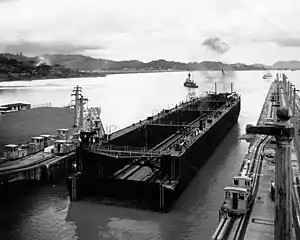
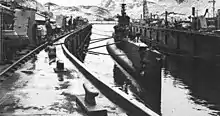
Built by Pacific Bridge Company in Alameda, California, and are 483 feet long, beam of 71 Feet, and draft of 5 Feet. Ship displacement 4,800 tons. Crew complement 6 Officers and 125 Enlisted. Armament of Two single Oerlikon 20 mm cannon. ARD had a crew of 100 to 160 men. ARD have a bow and are sea worthy. They are self-sustaining with a rudders to help in tow moving and have two cranes with a 5-ton capacity. Normal also had stowage barge for extra space. Used to repair destroyers and submarines. Class 2 could repair Landing Ship, Tank (LST). The stern of ship is open to have the ship in need of repair enter.[4][58]
- USS ARD-1 (displacement of 2200 tons) (Built in 1933) (only one in class)[59]
- USS ARD-2 sold in 1963[60]
- USS ARD-3 sold 1999[61]
- USS ARD-4 sold 1961[62]
- ARD-2-class 410 feet long, 49 feet, 4 inches wide, ARD-5 to 11:
- USS Waterford (ARD-5)[63]
- USS ARD-6 sold 1961[64]
- USS West Milton (ARD-7) Scrapped in 1992[65]
- USS ARD-8 sold 1961[66]
- USS ARD-9 sold 1977[67]
- USS ARD-10 sold, scrapped in 2014[68]
- USS ARD-11 sold 1977[69]
- ARD-2-class wide: 410 feet long, 49 feet, 4 inches 59 feet, 3 inches wide, ARD 12 to 32:
- USS ARD-12 sold 1987[70]
- USS ARD-13 sold 1977[71]
- USS ARD-14 sold 1980[72]
- USS ARD-15 sold 1971[73]
- USS ARD-16 by Pacific Bridge, sold moved to Mobile AL[74]
- USS ARD-17 sold 1971[75]
- USS Endurance ARD-18 ARDM 3, laid up at Charleston Naval Shipyard[76]
- USS Oak Ridge ARD-19 ARDM 1, to United States Coast Guard in 2002[77]
- USS White Sands ARD-20 by Pacific Bridge Co., (changed to AGDS-1), sold 1974[78]
- USS ARD-21 reserve[79]
- USS Windsor (ARD-22) sold 1976[80]
- USS ARD-23 sold 1992[81]
- USS ARD-24 sold 1982[82]
- USS ARD-25 sold 1973[83]
- USS Alamogordo ARD-26 sold 2000[84]
- USS ARD-27 Scrapped in 1974[85]
- USS ARD-28 sold renamed Capitan Rodriguez Zamora[86]
- USS Arco ARD-29 sold to Iran 1971[87]
- USS San Onfre (ARD-30) by Pacific Bridge Co.[88]
- USS ARD-31 To US Air Force in 1974[89]
- USS ARD-32 sold 1960[90]
- USS ARD-33 (By Dravo Corp.) renamed AFDL 47 Reliance[91]
Auxiliary Repair Dock, Concrete (ARDC)


Auxiliary Repair Dock, Concrete were mobile drydocks made of concrete, due to the shortage of steel during the war. ARDC had a 2,800 tons lifting capacity. ARDC were 389 feet long, 84 feet wide, and 40 feet deep. ARDC has a crew of five officers and 84 enlisted men. Each had a 5-ton crane, with a 42 feet reach. Eight were built at Wilmington, North Carolina, and five at San Pedro in Los Angeles, California.[92][93][94]
- ARDC 1 – Changed to AFDL-34 sold to Taiwan in 1959 Han Jih
- ARDC 2 – Changed to AFDL-35 scrapped in 1974
- ARDC 3 – Changed to AFDL-36 sold to Taiwan in 1947 Hay Tan, scuttled in 2000[95]
- ARDC 4 – Changed to AFDL-37 scrapped 1981
- ARDC 5 – Changed to AFDL-38 sold 1944 and 1981[96]
- ARDC 6 – Changed to AFDL-39 sold to Brazil 1980 Cidade de Natal
- ARDC 7 – Changed to AFDL-40 sold to the Philippines 1990
- ARDC 8 – Changed to AFDL-41 old 1983 to North Florida Shipyard[97]
- ARDC 9 – Changed to AFDL-42 sold to Hurley Marine 1945, scrapped in 1975
- ARDC 10 – Changed to AFDL-43 scrapped 1979[98]
- ARDC 11 – Changed to AFDL-44 sold the Philippines 1969[99]
- ARDC 12 – Changed to AFDL-45 sold to Todd Seattle 1945, sold 1981 to Puglia Engineering
- ARDC-13 – Changed to AFDL-46 destroyed at Bikini in 1946[100]
Yard Floating Dock (YFD)

Yard Floating Dock (YFD) was used for many types of floating docks. These were mostly used for harbor or shipyard use. YFD normally had no or little crew space and were serviced from shore. Some auxiliary Repair Dock were converted to YFD. Types of YFD were: 400-ton concrete docks, 1,000-ton, 3,000-ton and 5,000-ton wood docks; sectional wood docks from 7,000 to 20,000 tons lifting capacity and a three-piece self docking steel sectional docks with 14,000 to 18,000 tons lifting capacity. All Medium Auxiliary Floating Dry Docks were converted to YFD after the war.[101][102]
- USS Dewey (YFD-1) built in 1905
- USS YFD-2 Built in 1901. Damaged in the attack at Pearl Harbor on 7 December 1941 repaired.[3][103][104]
- USS Richland (YFD-64)
- Resolute (YFD-67), a medium auxiliary floating dry dock, retired in 2003.[105]
- USS YFD-3
- USS YFD-4
- USS YFD-5 USS Resourceful
- USS YFD-6 USS Competent
- USS YFD-7 USS Sustain
- USS YFD-8
- USS YFD-9
- USS YFD-10
- USS YFD-11
- USS YFD-12)
- USS YFD-13)
- USS YFD-14 USS Steadfast
- USS YFD-15
- USS YFD-16
- USS YFD-17)
- USS YFD-18)
- USS YFD-19)
- USS YFD-20
- USS YFD-21
- USS YFD-22
- USS YFD-23
- USS YFD-24
- USS YFD-25
- USS YFD-26
- USS YFD-27
- USS YFD-28
- USS YFD-29
- USS YFD-30
- USS YFD-31
- USS YFD-32
- USS YFD-33
- USS YFD-34
- USS YFD-35
- USS YFD-36
- USS YFD-37
- USS YFD-38
- USS YFD-39
- USS YFD-40
- USS YFD-41
- USS YFD-42
- USS YFD-43
- USS YFD-44
- USS YFD-45
- USS YFD-46
- USS YFD-47
- USS YFD-48
- USS YFD-49
- USS YFD-50
- USS YFD-51
- USS YFD-52
- USS YFD-53
- USS YFD-54
- USS YFD-55
- USS YFD-56
- USS YFD-57
- USS YFD-58
- USS YFD-59
- USS YFD-60
- USS YFD-61
- USS YFD-62
- USS YFD-63
- USS YFD-64
- USS YFD-65
- USS YFD-66
- USS YFD-67 USS Resolute
- USS YFD-68
- USS YFD-69
- USS YFD-70
- USS YFD-71
- USS YFD-72
- USS YFD-73
- USS YFD-74
- USS YFD-75
- USS YFD-76
- USS YFD-77
- USS YFD-78
- USS YFD-79
- USS YFD-80
- USS YFD-81
- USS YFD-82
Image gallery
_in_USS_AFDB-7.jpg.webp) USS Abraham Lincoln (SSBN-602) in USS AFDB-7
USS Abraham Lincoln (SSBN-602) in USS AFDB-7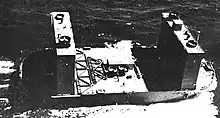 One Advance Base Sectional Dock (ABSD) section under tow with float wings up in 1944
One Advance Base Sectional Dock (ABSD) section under tow with float wings up in 1944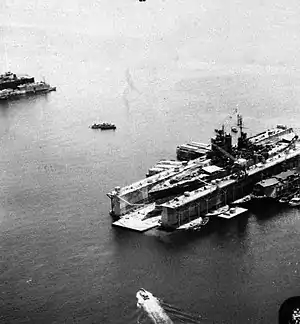 ABSD-5 at Manicani Island, Philippines repairing the USS Mississippi in July 1945
ABSD-5 at Manicani Island, Philippines repairing the USS Mississippi in July 1945_enters_floating_drydock_ABSD-6_at_Guam_on_8_June_1945_(NH_99118).jpg.webp) USS Makin Island (CVE-93) halfway into USS ABSD-6, at Guam, 8 June 1945
USS Makin Island (CVE-93) halfway into USS ABSD-6, at Guam, 8 June 1945 USS LST-646 and USS LST-662 in ABSD-6, in Apra Harbor, Guam, 29 May 1945
USS LST-646 and USS LST-662 in ABSD-6, in Apra Harbor, Guam, 29 May 1945 USS ABSD-6 being assembled at Apra Harbor, Guam in 1945
USS ABSD-6 being assembled at Apra Harbor, Guam in 1945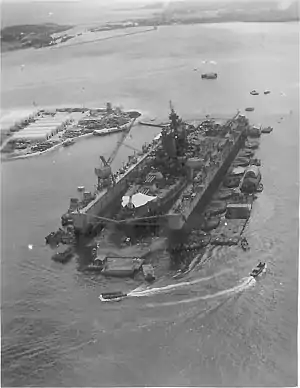 USS ABSD-3 at Guam, to the rear right of ABSD-3 is the land base that supported ABSD-6 and ABSD-3 crew
USS ABSD-3 at Guam, to the rear right of ABSD-3 is the land base that supported ABSD-6 and ABSD-3 crew.jpg.webp) USS Octans (AF-26) in YFD-18 at San Francisco on 15 June 1943
USS Octans (AF-26) in YFD-18 at San Francisco on 15 June 1943 USS Iowa (BB-61) Floating Drydock
USS Iowa (BB-61) Floating Drydock USS AFDB-2 at Seeadler Harbor in 1945
USS AFDB-2 at Seeadler Harbor in 1945 ABSD-6's Section D and one crane under tow to Guam. pontoons are folded down to reduce wind resistance and lower center of gravity
ABSD-6's Section D and one crane under tow to Guam. pontoons are folded down to reduce wind resistance and lower center of gravity ABSD-3 repairing small ships at the same time at Guam in 1945
ABSD-3 repairing small ships at the same time at Guam in 1945_docked_in_ABSD-1_at_Espiritu_Santo%252C_in_January_1944.jpg.webp) Columbia (CL-56) docked in Artisan ABSD-1
Columbia (CL-56) docked in Artisan ABSD-1_docks_in_ABSD-1_at_Espiritu_Santo%252C_in_January_1944.jpg.webp) Columbia docked upon Artisan
Columbia docked upon Artisan AFDB-1 with West Virginia (BB-48) high and dry in the dock
AFDB-1 with West Virginia (BB-48) high and dry in the dock.JPEG.webp)
_in_Drydock_Dewey.jpg.webp) USS Pennsylvania (ACR-4) in Drydock Dewey, c. 1906–1907
USS Pennsylvania (ACR-4) in Drydock Dewey, c. 1906–1907_in_Drydock_Dewey.jpg.webp) USS Maryland (ACR-8) in Drydock Dewey, c. 1907
USS Maryland (ACR-8) in Drydock Dewey, c. 1907 USS Chauncey (DD-3) in Drydock Dewey, c. 1910
USS Chauncey (DD-3) in Drydock Dewey, c. 1910 USS Chauncey (DD-3) in Drydock Dewey, stern view, c. 1910
USS Chauncey (DD-3) in Drydock Dewey, stern view, c. 1910 US Navy submarines in Drydock Dewey, c. 1912
US Navy submarines in Drydock Dewey, c. 1912 US Navy submarines in Drydock Dewey, c. 1912
US Navy submarines in Drydock Dewey, c. 1912_in_Drydock_Dewey%252C_c._1916.jpg.webp) USS Galveston (CL-19) in Drydock Dewey, c. 1916
USS Galveston (CL-19) in Drydock Dewey, c. 1916 Aerial view of the Dewey Drydock with USS Jason (AV-2) nearby, October 1928
Aerial view of the Dewey Drydock with USS Jason (AV-2) nearby, October 1928_in_Drydock_Dewey%252C_aerial_view.jpg.webp) Aerial view of USS Jason (AV-2) in Drydock Dewey, 8 March 1932
Aerial view of USS Jason (AV-2) in Drydock Dewey, 8 March 1932_in_Drydock_Dewey%252C_side_view.jpg.webp) Side view of USS Jason (AV-2) in Drydock Dewey, 9 March 1932
Side view of USS Jason (AV-2) in Drydock Dewey, 9 March 1932_Badge.gif) Official crest of Arco (ARDM-5)
Official crest of Arco (ARDM-5)%252C_nicknamed_The_Ghost_of_the_Coast%252C_enters_the_floating_dry_dock_Arco_(ARDM_5)_for_a_scheduled_maintenance_period_aboard_Naval_Base_Point.jpg.webp) Los Angeles class fast attack submarine USS Asheville (SSN-758) enters the floating dry dock of Arco (ARDM-5) for scheduled maintenance.
Los Angeles class fast attack submarine USS Asheville (SSN-758) enters the floating dry dock of Arco (ARDM-5) for scheduled maintenance.
See also
- Dry dock
- Heavy-lift ship
- Hughes Mining Barge
- PD-50 Russia's largest floating dry dock.
- Semi-submersible naval vessel
- Semi-submersible platform
- List of auxiliaries of the United States Navy
References
- The Pacific War Online Encyclopedia, Floating Dry Docks
- navsource, YFD-2
- "Floating Dry-Docks (AFDB, AFDM, AFDL, ARD, ARDM, YFD)". shipbuildinghistory.com. 30 April 2015. Retrieved 8 January 2019.
- USS ABSD-1 [1943-1946]
- "Sea Going Navy Yard Follows The Fleet", November 1945, Popular Science
- navsource, Artisan (AFDB-1)
- southpacificwwiimuseum.com, ABSD-1 Floating Dry Dock on Espiritu Santo, A glimpse of WWII history
- pacificwrecks, USS AFDB-2
- navsource, USS AFDB-3
- Photos of USS Samuel B. Roberts on blocks in AFDB-3 in 1988
- Pacific Wrecks - AFDB-4 / ABSD-4 Auxiliary Floating Dry Dock 4
- navsource, navsource, ABSD-4
- USS AFDB-5
- navsource, USS AFDB-6
- navsource, AFDM Medium Auxiliary Floating Dry Dock
- navsource, Medium Auxiliary Floating Dry Docks (AFDM)
- USN Floating Dry Dock AFDM-1 in the Miraflores Locks, August 11, 2013
- navsource, AFDM-1
- navsource, USS AFDM-3
- navsource, USS Resourceful (AFDM-5)
- Global security AFDB Auxiliary Floating Dry Dock, Large
- navsource, USS Competent (AFDM-6)
- navsource, USS Sustain (AFDM-7)
- navsource, USS Richland (AFDM-8)
- navsource, USS AFDM-9
- navsource, USS Steadfast (AFDM-14)
- navsource.org, USS Ability (AFDL-7)
- US Navy, AFDL: SMALL AUXILIARY FLOATING DRY DOCK (N-S-P)
- navsource, USS AFD-2
- navsource, USS AFD-3
- navsource, USS AFD-4
- navsource, USS AFD-5
- navsource, USS Dynamic (AFD-6)
- navsource, USS Ability (AFD-7)
- navsource, USS AFD-8
- navsource, USS AFD-9
- navsource, USS AFD-10
- navsource, USS AFD-11
- USS AFD-12
- "Casualties, Navy & Coast Guard ships WWII". history.navy.mil. Archived from the original on 10 April 2014. Retrieved 9 March 2014.
- Beans, Bullets, and Black Oil, By Rear Adm. Worrall Reed Carter, page repair
- Beans, Bullets, and Black Oil, By Rear Adm. Worrall Reed Carter, page Enewetak Atoll July 1944
- navsource, USS AFD-16
- Beans, Bullets, and Black Oil, By Rear Adm. Worrall Reed Carter, page Kwajalein Atoll Sept. 1944
- Dunstaffnage, war years
- Fold3.com, War Diary, 1/1-31/45 › Page 1
- navsource, USS AFD-21
- navsource, USS AFD-22
- navsource,USS Adept (AFD-23)
- USS AFD-24
- US Navy AFDL 25
- USS AFD-26
- navsource, USS AFD-28
- Dictionary of American Naval Fighting Ships, edited by James L. Mooney, page 709
- navsource, USS AFD-30
- HMS ST BRIDES BAY (K 600) - Bay-class Frigate
- NAVY DEPARTMENT, MANUAL OF ADVANCED BASE DEVELOPMENT AND MAINTENANCE, APRIL 1945
- navsource, USS ARD-1
- navsource, USS ARD-2
- navsource, USS ARD-3
- navsource, USS ARD-4
- navsource, USS ARD-5
- navsource, USS ARD-6
- USS ARD-7
- navsource, USS ARD-8
- navsource, ARD-9
- navsource, ARD-10
- navsource, ARD-11
- ARD-12
- ARD-13
- navsource, USS ARD-14
- USS ARD-15
- navsource, USS ARD-16
- USS ARD-17
- navsource, USS Endurance ARD-18 ARDM 3
- USS Oak Ridge (ARDM-1) ARD-19
- navsource, USS White Sands (ARD-20)
- navsource, USS ARD-21
- navsource, USS ARD-22 Windsor
- navsource, USS ARD-23
- USS ARD-24
- USS ARD-25
- navsource, USS Alamogordo (ARDM-2) ARD-26
- USS ARD-27
- navsource, USS ARD-28
- USS Arco (ARD-29)
- navsource, USS ARD-30, USS San Onfre
- navsource, USS ARD-31
- navsource, USS ARD-32
- navsource, USS ARD-33 - AFDL 47, Reliance
- "Final Report for Tests Able and Baker". Joint Task Force One. Bureau of Yards and Docks Group. 1946.
- Dictionary of American Naval Fighting Ships: V. 6: R Through S, Appendices, By James L. Mooney.
- Global security, Auxiliary Classes
- navsource, ARDC 3
- navsource, ARDC 5
- navsource, ARDC 8
- navsource, ARDC 10
- navsource, ARDC 11
- navsource, ARDC-13
- navsource, Yard Floating Dock (YFD)
- The Navy of the Nuclear Age, 1947–2007, By Paul Silverstone
- US Navy, YFD-2
- National Park Service, Civilian Casualties, YFD-2
- US Navy, Floating Drydock Resolute Ends 58 Years of Service to Navy, Story Number: NNS031107-31Release Date: 11/7/2003 11:40:00 PM, By Chief Journalist (SW/AW) Mark O. Piggott, Commander, Submarine Force, U.S. Atlantic Fleet Public Affairs
External links
- This article includes information collected from the Naval Vessel Register, which, as a U.S. government publication, is in the public domain. The entries can be found here and here. – sections a, g, h, i, j, and e
- This article includes information collected from the Naval Vessel Register, which, as a U.S. government publication, is in the public domain. The entry can be found here. – section f
- This article includes information collected from the Naval Vessel Register, which, as a U.S. government publication, is in the public domain. The entries can be found here and here. – IX-521 and IX-525
- Youtube, BATTLESHIP USS IDAHO REPAIRED AT ESPIRITU SANTO in 1944 in USS Artisan (ABSD-1)1
- Youtube, August 15, 1944 mighty battleship Idaho at ABSD-1
- Youtube, Floating Dry Docks WWII
- US Navy, Beans, Bullets, and Black Oil, The Story of Fleet Logistics Afloat in the Pacific During World War II
| Wikimedia Commons has media related to Floating drydocks of the United States Navy. |
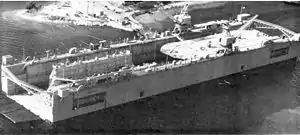
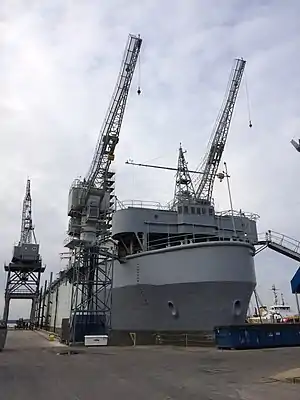
.jpg.webp)
